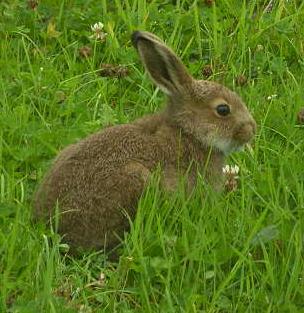Source(s): Susan Zaro, DeKalb County Master Gardener Volunteer, College of Agricultural and Environmental Sciences.
Rabbits can do considerable damage to the landscape. For the most effective control, a variety of methods should be tried, including habitat modification, fencing, trapping, chemical repellents and the use of rabbit-resistant perennials.
Removing dense, heavy vegetative cover, brush piles, weed patches, junk dumps and stone piles adjacent to the landscape will help eliminate rabbit habitats. Fencing made from chicken wire, with mesh less than 1 “, can be placed around a vegetable garden or herbaceous plant border. The fence must be at least 2′ high with the bottom buried at least 3″ deep. You can also use cylinders of 1/4″ wire hardware cloth extending higher than a rabbit’s reach by placing them around the trunks of individual trees and shrubs. Bury the bottom of the cylinders 2″ to 3″ inches below ground level and place them 1 ” to 2″ inches from the trunk.
Live traps, most effective in winter, can be baited with corn cobs, oats, dried apples or rabbit droppings can also be used but then you must be ready to relocate the live animal.
Chemical repellents, which take advantage of a rabbit’s keen sense of smell and taste, can discourage rabbit browsing. Try one or more of the following:
- Dried blood meal
- Mole Med or Scoot Mole
- Predator Scent
- Repel
- Hinder
- Human hair
- Scott Rabbit
- Used kitty litter sprinkled around edges of garden
- Animal lard smeared on tree trunks
- Onions interspersed with other crops
- Ropel and Bonide rabbit-deer repellent
Note: These methods have not been tested by the University of Georgia, so their use is at your own discretion. Before applying, test the safety and effectiveness of products on a small area of your garden first.
Plastic snakes or owl decoys can scare away some rabbits, but often only on a temporary basis.
Another method for ridding the landscape of rabbits is setting half filled quart jars with water around the garden, although no one is sure why this has been found to be effective.
Finally, there are plants that are not as attractive a food source as some others:
- Yarrow
- Hosta
- Monkshood
- Red Hot Poker
- Wormwood
- Geranium
- Aster
- Iris
- Astilbe
- Bishop’s Hat
- Bellflower
- Narcissus
- Wild Indigo
- Yucca
- Snakeroot
- Oriental Poppy
- Autumn Crocus
- Lamb’s Ear
- Foxglove
- Sedum
- Daylily
- Globe Flower
- Leopards Bane
- Meadow Sage
- Meadowsweet
- Bergenia
If the presence of these adorable yet annoying creatures has you stewing, try a combination of the approaches mentioned above to gain the upper hand.
Center Publication Number: 37
- Discouraging Rabbits - September 23, 2013
